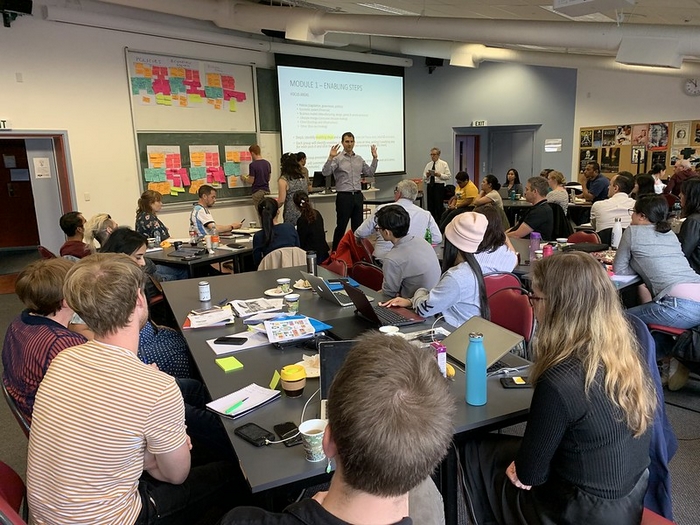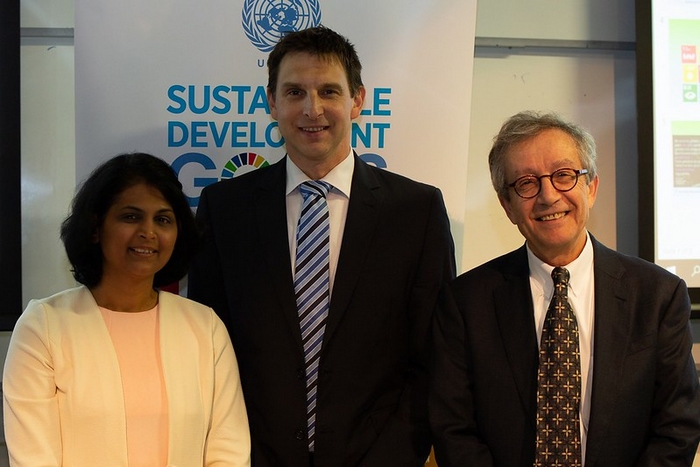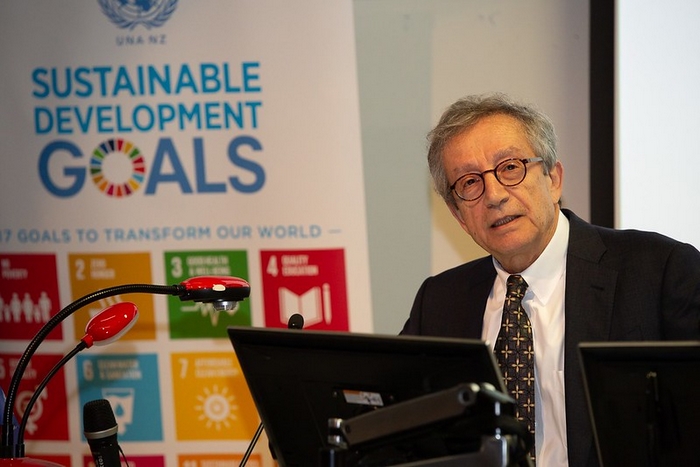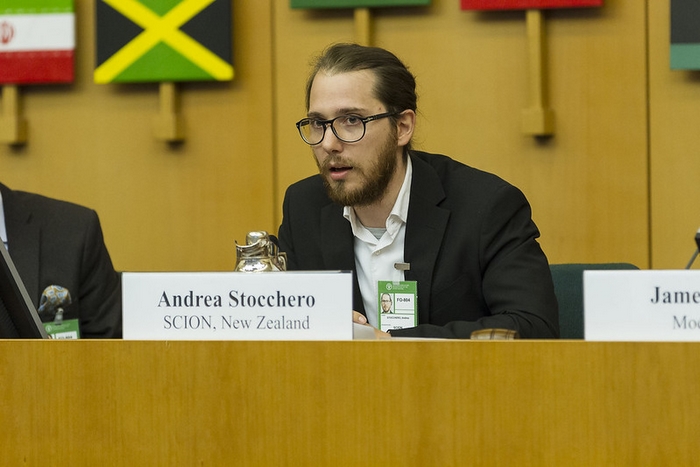Circular bioeconomy Q&A

System-wide changes such as transitioning to the circular bioeconomy require unprecedented collaboration and transparency across industries, government and community. It presents a huge challenge for the next generation of policy makers that will help to transform our economy into this new circular model. They will be creating policy for a world that faces environmental, social and economic problems and fundamental uncertainty.
Professor Girol Karacaoglu, Head of the School of Policy and Government at Victoria University of Wellington, is faced by this very dilemma. To prepare his policy and management students, Professor Girol decided to expose them to the diverse elements (including finance, policy, leadership, resilience, environment and innovation) of the linear to circular transition. Girol invited Scion’s Andrea Stocchero and Florian Graichen to speak with his audience of future policy makers about the role of ‘innovation’ in the circular bioeconomy and in circular cities.
Following their time with the students, Girol (GK), Florian (FG), and Andrea (AS) shared their perspectives on this transformation.

Why do we need a circular bioeconomy in New Zealand?
FG: The transition to a circular bioeconomy in New Zealand is a golden opportunity for our generation. We can create value chains from gene to product that meet increasing sustainability demand onshore and internationally. If we transition our economy now, New Zealand in 2050 would have a high tech, resource-efficient and competitive economy with zero net greenhouse gas emissions.
AS: The current linear economy model has proven unfit to provide urgently needed solutions to stop, reverse, or even mitigate current trends like climate change, resource depletion, in the context of rapidly increasing population growth. The circular bioeconomy is an important component in achieving future resilience, adaptability and sustainability.
GK: We have no idea what future generations will value and how they will want to live. We require an economy and society that ensures opportunities – we need to prepare ‘the garden’ that will provide them with the opportunities to survive and thrive – i.e. flourish, as they live the lives they value, in safety.
Transition to a circular bioeconomy will make it possible for individuals and communities to live the kinds of lives they value, in the present and into the future without compromising others’ rights to do the same.
How do we kick start the circular bioeconomy transition in New Zealand?
FG: A key enabler would be a national circular bioeconomy strategy for New Zealand. We need a triple helix model of transition - including academia, cross sectorial industry and government - to ensure all opportunities and challenges are identified.
AS: Recognising and mapping the widespread and interconnected benefits that circular bioeconomy would bring to New Zealand’s society, economy and natural environment, is necessary to generate the momentum and traction needed to deploy such transition.
GK: Intergenerational wellbeing has to become a more dominant government objective. Parliament should specify intergenerational wellbeing as the core objective of public policy. Furthermore, through appropriate legislation, it declares that each government will be held accountable for pursuing public policies that promote intergenerational wellbeing – now and in the future.
Why is collaboration the key to success?
FG: Successful transition will require not only new technologies but also the sharing of value and risk across all participating sectors and government. Companies and whole industries that traditionally were operating in separate value chains will have to work together and be linked in new value networks.
AS: A holistic, integrated, systems approach is necessary to harness interdependent opportunities across value chains, sectors, the economy, the community and the planetary systems. The transition to circularity will require the expertise and capacity generated from new collaborations and synergies across those same areas and systems.
GK: What is most important is the degree of inclusiveness of these processes. The fact that individual and family lives are lived in social settings, and the imperative of social cohesion for sustainable wellbeing, makes collaboration and community engagement as full participants with the whole public policy and management process critical.
What will happen if we don’t transition to a circular bioeconomy?
FG: Climate change, living beyond our means and population growth are truly global challenges. It affects all regions, people and economies across the world. Living outside planetary boundaries is simply not an option.
AS: The concept of unlimited growth, when reliant on finite resources and a linear economy model, is revealing itself as a mirage threatening future generations’ wellbeing. The Earth’s regeneration capacity is limited and future resource scarcity, or extinction, will force lifestyles and business models to adapt and even radically change.
GK: As a country we would compromise our ability to ensure a broader environment in which wellbeing is attainable on a sustainable basis, across generations. The fundamental foundations of our sustainable collective wellbeing would be jeopardised.

Girol
What should finance look like in the circular bioeconomy?
There is a critical nexus between finance and sustained development, which provides not only a bridge between long-term development and finance, but also a distinctive role for public policy. Innovation-supporting investment needs a long-term commitment, supported by ‘patient finance’, as well as an appetite for risk-taking in the face of ‘radical uncertainty’. This is especially the case when we are talking about transformative infrastructure investments, such as those supporting ‘green growth’, nanotechnology, biotechnology, and others.
What are the big government policy hurdles?
Wellbeing-Focused Public Policy has to take the fundamental shift, from linear to circular society, into account. These are the circumstances when the state needs to lead (and has historically done so); only then does the private sector (including venture capital) follow (Mazzucato and Wray 2015; Mazzucato and Perez 2014; Mazzucato and Semienuk 2018).
Is economic growth possible/viable in a circular bioeconomy?
Economic growth in a circular bioeconomy is not an oxymoron, they do not contradict each other. Taking circular bioeconomy approaches as guiding principles - science and technology advancements coupled with appropriate public policy, finance and investment approaches – will ensure economic growth within planetary boundaries for future generations.
What kind of governance structures do we need to put in place to get us to a circular bioeconomy?
- Clearly separate the short-term (three year) management role of government, from the long-term stewardship role of Parliament.
- Each government will be held accountable for pursuing public policies that promote intergenerational wellbeing.
- A dedicated investment manager plays the public sector stewardship role.
- Funding could be provided through a “strategic” portfolio allocation (say 20%) from the NZ Superannuation Fund).
Andrea
Why is the built environment important to a successful circular bioeconomy?
The built environment is where most human activities happen and where most resources are consumed, created for, transported to, wasted, emitted and disposed from. As such, the built environment has a prominent role in enabling and sustaining a successful circular bioeconomy.
What challenges do we need to overcome to make our built environment circular?
Transitioning to circularity within the built environment will require fundamental changes to the local physical built, social and cultural structures. Those changes will need to reach social acceptance and support, to be empowered and enabled to overcome market and infrastructural barriers, including financial, regulatory and governance, business and industries’ resilience to change. Design, construction and technology limitations exist, and innovation is urgently needed across sectors and processes.
Are the challenges in our cities, the same as in our regions?
The challenges will be different according to the specific characteristic of any local context. For example, population density and dynamics, access to resources, energy and infrastructures are among the key factors that will influence local challenges and opportunities. However, a circular bioeconomy will support and be supported by the transition towards regenerative built environments. It’s possible that challenges and solutions for our regions will inform solutions and approaches applicable to urban areas and vice versa.
Is it possible to create a built environment, that is circular, sustainable, healthy and affordable?
We have the technologies and best practices to achieve regenerative building and community development, including low-energy, carbon positive, low-environmental impact and healthy buildings. In a context within which intergenerational wellbeing is valued, and truly strived for, to create a built environment that is simultaneously circular, sustainable, healthy and affordable is not only necessary, but also feasible.

Florian
What are the opportunities for New Zealand’s manufacturing sector if we embrace a circular bioeconomy?
New Zealand could be one of the big winners of a global transition to circular bioeconomies. The transition is creating employment opportunities across the full set of skills and competencies needed in a multidisciplinary, diverse and innovative biobased sector across rural, coastal and urban areas - uplifting local economies. We can produce food, feed, bio-based products, services and bioenergy while preserving ecosystems.
Why/how is New Zealand unique in how we approach manufacturing in the circular bioeconomy?
New Zealand does not have a large legacy of older manufacturing technology that would need to be incorporated to minimise financial outlay. We have a relatively blank slate, allowing us to move immediately to a modern state of manufacturing. Instead of exporting commodity feedstock, we can create a biorefining and biomanufacturing industry onshore that exports sustainable products of significant higher value and that link into global value chains and networks.
How will centralised, regional, mobile manufacturing models be used?
Consumers are increasingly expecting manufacturers to switch from fossil fuel-based resources to renewable biobased resources, and to adopt circular economy principles where materials are used and reused efficiently. These drivers lend themselves to a new decentralised model for bioproduct manufacturing in New Zealand.
Distributed manufacturing breaks up the manufacturing process, so that different stages of production can take place in different areas. It is a direct contrast to standard, centralised manufacturing, which requires resources and materials to be transported to a central location where the processing takes place.
What will be the key technologies in New Zealand’s circular bioeconomy manufacturing sector?
- Biorefinery solutions and infrastructure – both for energy as well as high-value materials and products.
- De-centralised manufacturing close to renewable resources.
- Additive manufacturing technologies using biobased resources and reducing the need to manufacture at scale.
- Designer forests – customised feedstock for the circular bioeconomy.
Background of interviewees
Professor Girol Karacaoglu (GK), economist and head of the School of Government at Victoria University of Wellington. Girol has had significant experience in developing public policy through roles in finance including as Chief Economist at New Zealand Treasury.
Dr Florian Graichen (FG), chemist and leader of Scion’s biopolymers and chemicals research and development.
Andrea Stocchero (AS), sustainable architect and researcher in Scion’s built environment area.
